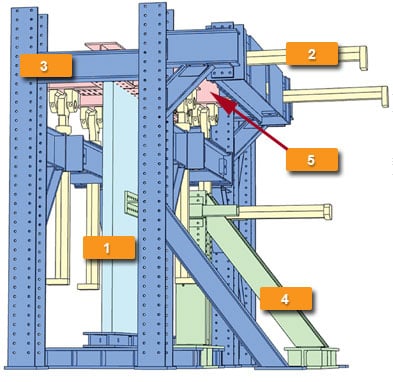
When an earthquake strikes, when a hurricane hits, what causes screws to separate from sheets of drywall? Steel beams to bend and buckle a fraction of an inch? And just how many small jolts and jostles, torques and twists, does it take before a ceiling caves in or a parking garage collapses? Ben Schafer’s “Big Blue Baby,” the prized progeny of his Thin-walled Structures Lab in Latrobe Hall’s basement, is providing the answers.
What it is:
The Big Blue Baby (BBB) is a one-of-a-kind, multi-axis structural testing rig.
How it works:
![]() Specimen: The wall of a building made of cold-formed steel with sheets of plywood or drywall screwed to it, approximating 1/5 of an actual wall, is placed in the middle of the BBB.
Specimen: The wall of a building made of cold-formed steel with sheets of plywood or drywall screwed to it, approximating 1/5 of an actual wall, is placed in the middle of the BBB.
Position transducers are placed on the exterior and interior of the specimen, flush with the sheathing material and the stud. These transducers are used to measure the distance the stud moves when pressure is applied from multiple directions and along with load cells convert these forces and displacements to measurable electrical output: voltage.
![]() Hydraulic Actuators: The rig’s most important part, these connect to the load cells and are used to apply vertical and/or hori-zontal force to the specimen. The BBB is capable of providing 200,000 lbs. of vertical force (the equivalent of 100 Volkswagen Beetles) and 50,000 lbs. of horizontal in-plane force, 50,000 lbs. of horizontal out-of-plane force, and 400 kip-ft overturning moment.
Hydraulic Actuators: The rig’s most important part, these connect to the load cells and are used to apply vertical and/or hori-zontal force to the specimen. The BBB is capable of providing 200,000 lbs. of vertical force (the equivalent of 100 Volkswagen Beetles) and 50,000 lbs. of horizontal in-plane force, 50,000 lbs. of horizontal out-of-plane force, and 400 kip-ft overturning moment.
The load is applied gradually, and potentially in multiple directions, at increments as slow as .01″/min. As the actuators move, a computer records the readings of the position transducers, and lab members are on hand to observe the specimen’s response. They look for wrinkles in the sheathing, screws popping out, any signs that the stud is stressing. “When nothing happens, we increase the force,” Peterman says. “Often, we won’t know the whole story until it fails and we take the wall apart.”
![]() Reaction Frame: Bringing all the forces developed from the actuators back to the ground, and accommodating the multi-axis twists and turns, requires a unique reaction frame.
Reaction Frame: Bringing all the forces developed from the actuators back to the ground, and accommodating the multi-axis twists and turns, requires a unique reaction frame.
![]() Lateral Reaction Frame: A simpler version of the big reaction frame is used to apply load directly from the side.
Lateral Reaction Frame: A simpler version of the big reaction frame is used to apply load directly from the side.
![]() Controllable Loading Platen: The actuators provide multi-axis movement of this large assemblage of steel so the specimen can be crushed, twisted, bent, or generally abused as it would be during a hurricane, earthquake, or other calamity.
Controllable Loading Platen: The actuators provide multi-axis movement of this large assemblage of steel so the specimen can be crushed, twisted, bent, or generally abused as it would be during a hurricane, earthquake, or other calamity.
What it does:
It allows researchers to test the strength and stability of building materials, including their resistance to tremendous vertical and horizontal force, as well as shaking and twisting. Designed and constructed at Hopkins, it’s one of only three apparatus in the United States that can combine all of these different forces in one piece of equipment.
Why it’s important:
Grad student Kara Peterman explains, “People are always trying to push the limits of materials.” Whether it’s skyscrapers or the steel racks lining Home Depot’s aisles, “we want everything to be thinner, lighter, and stronger.”
The conditions the BBB simulate enable Hopkins researchers to write the formulas that determine just how far these materials can be pushed. Their findings help define the optimal design and composition of cold-formed-steel columns, beams, fasteners, and sheathing, and the building codes that will make structures better able to withstand hurricanes, earthquakes, gravity loads, and any other stresses that may come their way.
Schafer is currently using the BBB to study how seismic forces affect cold-formed-steel buildings, up to nine stories high, as part of a three-year $925,000 National Science Foundation grant he received in 2010.
The Final Product:
Better design is the BBB’s final byproduct. The data collected by the BBB are used in formulas that Schafer and his students write, most of which are utilized in the design specifications structural engineers use every day; of course their findings are also published in journals, presented at conferences, and provided to industry and the public, online, free of charge at cejhu.edu/bschafer.
Stats:
Dimensions: 8′ wide x 12′ long x 10′ high
Conceptual Design: Ben Schafer, the Swirnow Family Faculty Scholar and Professor and Chair of Civil Engineering
Structural Design and Rendering: Rachel Sangree, Associate Research Engineer
Construction: Nickolay Logvinovsky, Senior Instrument Designer
CAD Model: Microstation provided by: Bentley Systems and Buddy Cleveland ’72
External Funding: National Science Foundation, American Iron and Steel Institute




